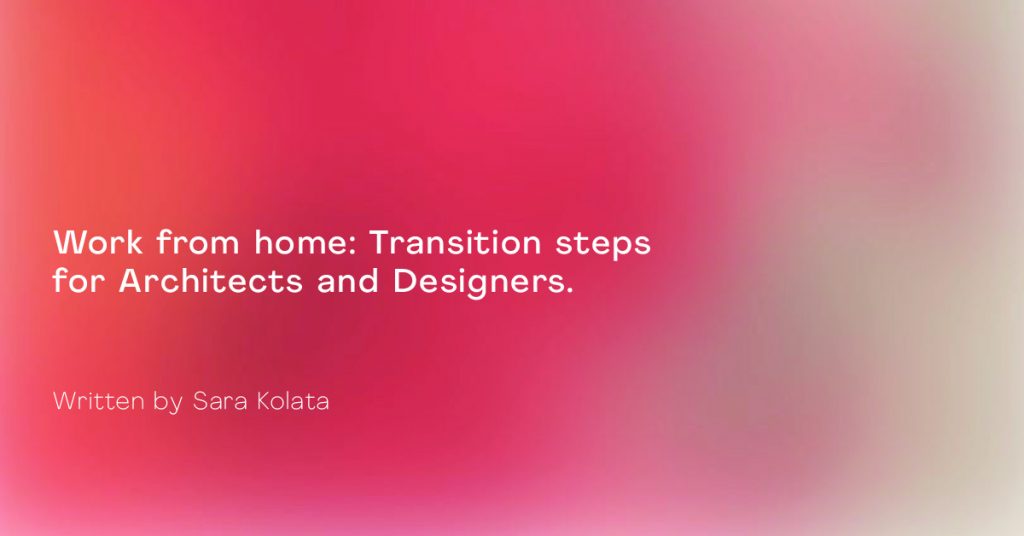
For most service-based businesses the prospect of working from home might feel overwhelming and frankly quite scary.
The increasing uncertainty and anxiety about the personal dangers from the epidemic and its impact on the economy will make the challenge of adjusting to these work changes even greater.
In this article I cover strategies that you can implement, in order to ensure that your design team continues to collaborate effectively and maintain momentum in the business.
Teams that suddenly undergo change of work patterns can encounter a lot of chaos, which may result in decreased effectiveness, and a lot of time waste. Those kinds of transitions may be very expensive and sometimes even fatal for the business. In order to avoid being a victim you have to rethink ways in which you can keep at your tasks but within a new scenario. This is the moment when your ability to effectively lead is going to be the most tested, so you need to ensure readiness for the transition.
Take a day to re-structure and re-think
I strongly encourage you to look at this time of turmoil as an opportunity and try to evaluate your work as a whole. There surely are things you never get round into doing, like publishing, writing articles, cleaning up your desktop, updating your website, connecting with certain people, negotiating new business deals or rethinking your client acquisition strategy. If this is the case, today is the day for you to sit down and consider how to overcome those issues and make a strong plan of action.
While you work on drafting a clean plan, you can encourage your team to revisit the basics in order to ensure everyone understands team objectives, their individual roles and how each person contributes to an outcome.
You can ask them to do homework and come up with a three-minute presentation of what, according to them, should be their individual biggest focus for the time of isolation. Perhaps they themselves in their everyday work are too busy to tidy up the trail of unfinished tasks they leave behind, when moving from project to project. It could be an incredible opportunity for you and your whole team to rethink your strategy and catch up on things, which have drugged behind. Make sure you communicate this clearly. This is not a rest day, it’s a day of re-evaluation and as a result give everyone mandatory homework.
Set clear goals and distribute roles
One of the most important things you and your team need to think about is your goals and roles.
Lets say it straight. Some of the design projects you have just been involved in are going to suffer. And yes, not everything is going to move as smooth as when you work together side by side. The best approach is to acknowledge the loss and to move ahead with a strong new focus. Re-evaluate what will you loose, and what are the things that you simply need to give up on, because they are not possible to get accomplished right now. Accept this and move on.
Than, look into those tasks that you can still make-work with your team and write them down clearly.
Each member of your team should come out of this exercise with a clearly defined role. Role distribution also helps in organizing your communication channels. If everyone knows their responsibilities they will reach out to one another when encountering any difficulties instead of constantly reaching out to their leader. This increased communication amongst the team can also help less active members stay involved.
One thing to remember is that goal setting and role distribution is not just a one off practice. Throughout the time of isolation you will have to coordinate such exercise as often as it feels needed. New work ethic will generate new and competing tasks across the business and you will have to re-group after each accomplishment. Watch out for ever-expanding list of tasks and ensure that with the process of delegation you communicate clearly with your team.
Map skills and capacity.
Most designers these days work on multiple projects and with multiple teams and once. In these times it’s likely that one, if not more of them, will be put on hold, indefinitely. To minimize the impact of the shock, think already about where you have skills redundancy on your team or ways in which you can outsource help.
A number of new tasks may result in getting many of your team members pulled in different directions. People will also take time to adapt and its inevitable that productivity will go down. Try to not overstress anyone on the team by expecting people to handle all tensions on their own. Try to make yourself available and hold your own spirit high by first and foremost accepting that it’s a time of unexpected and unforeseeable changes and its ok to go through this transformation. Adaptability is key right now.
Being adaptable may mean bringing new resources into the team. You may need external expertise to help you evaluate how the epidemic affects your business and serve expert advice as to ways to save it. You may also consider hiring a marketing expert to figure out how to launch a new product if your trade shows get cancelled. If you are looking into those options, feel free to direct email me on LinkedIn I will be happy to connect you with professionals in our industry.
On-boarding a new team member may not be easy but it may prove the best thing for you to do right now.
If you do decide to implement changes into your team structure take the time to properly integrate newcomers into your team.
Emphasize Personal Interactions.
People suddenly forced to adopt into working form home might feel disconnected and lonely, which as a result lowers productivity and engagement. If you are not used to managing virtual teams, you may feel overwhelmed by just that and find it hard to keep your team up to date.
Under stress and pressure it is easy to become task focused. It is however very important to leave time and space for personal interactions.
How can you do this most effectively?
Keep everyone in mind. Inevitably we all seem to sympathize with a certain demographic, amongst our peers, more than others. Despite your personal bias remember that in times of turmoil, such as this one, inclusivity is more important than ever. There might be less expressive, more introverted people on your team who quite easily may fall into the background when working remotely. To not allow yourself to fall into his trap make a team map, positioning your strong players in the front and pairing them up with one less active individual. Instruct them to work together, give them a clear task, set expectation and suggest a platform that they can communicate on.
Communicate with everyone regularly.
From the get go decide on one or two days a week (or as many as you feel suitable) which are going to be treated as milestones for your team. Than divide the tasks amongst everyone weekly. At the meeting give everyone room for presenting their work and mentioning their results. Plan your meetings more often that you think you need them. In practice it will be easier for you to cancel a meeting than to call one on in time of emergency. By having them set regularly you will not have to act alarmed and can always wait for the next meeting to raise the issues and resolve concerns.
Create space for chitchat
Within the communication platform of your choosing make room for people to just exchange simple conversations, to joke and to interact with each other on the non-work related themes. Also, set norms where people call each other casually instead of waiting for official meetings.
Do not rely on email!
Make sure the communication between everyone is interactive and personal, not official. Switch to face-time, use video conference software, web chat and phone calls. Go with these channels that help people read each other’s emotions and help to boost morale.
Avoid distractions and misunderstandings
Try to stay open-minded to new ways of communication, withhold your judgments about people’s behavior on new communication platforms. Everyone will be adapting to new ways of communication. Written communication removes the emotional aspect of expression, which often is a key factor of how we read one another. Tone of voice is extremely important which is one of the reasons why you should try to maintain a verbal communication above all. But if you do communicate mainly through writing, try not to forget about the limits of this communication and don’t fall victim to misunderstandings related to this. It also applies to watching people’s behavior during group virtual meetings. If people mute their channels, consider that this might be their care to avoid unnecessary noise pollution on call. Similarly if people don’t speak up, understand that it might be because they find it harder to tell when is their turn, as not many people are used to virtual meetings. One of very interesting exercises you can adopt would be to ask everyone to give a 3 minute virtual tour of their surroundings or share something personal from their time in isolation. That way you can help build an environment of further compassion and inclusion. It is possible that people will relate to each other better that way.
Don’t assume or stereotype.
Having a view to your team’s personal life can be quite exposing to some. Your team may not share similar economic status; some may live in shared apartments with many other flat-mates present. They might have to look after their children whiles working or simply have other distractions around them. Try to understand those circumstances. Not everyone will find it easy to focus when working form home, and we all might share completely diverse home settings so it’s important to stay open to all those aspects.
Global pandemic, isolation and all the change associated with it will create a lot of disruption. You can use strategies to respond effectively and continue to deliver against your business goals.
Remember that disruption creates opportunity, so allow yourself to explore new ways of working.

Hello, I’m Sara Kolata
After running my own architecture practice I learned the ins and outs of the service-based design industry. It was a beautiful journey but also one of the strongest life lessons experienced. After six years, I decided to never again rest 100% of my income sources on selling services. Entrepreneurship is about turning what excites me in life into capital so that I can do more of it and help others experience the abundance that surrounds us.
Today I help architect and designer experts build a digital presence and position themselves as experts online. I am interested in discovering and testing alternative ways of income generation for specialists in the architecture design industry as well as exploring limitless possibilities of online education. I believe that every business in the world has to embrace digital transformation to grow and expand.
To learn more, please visit my website www.sarakolata.com

Leave a Reply